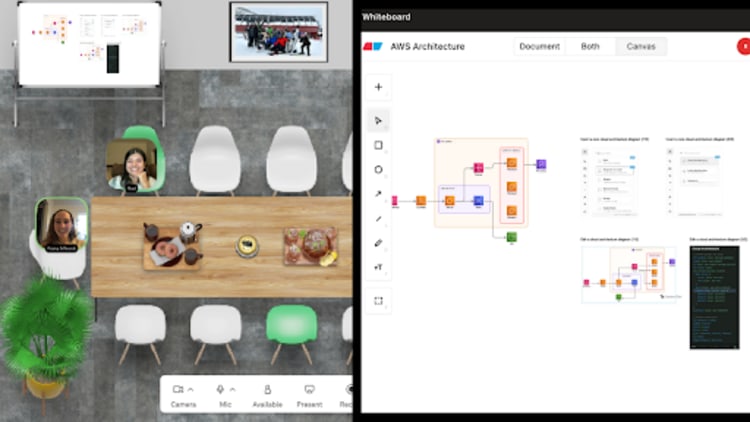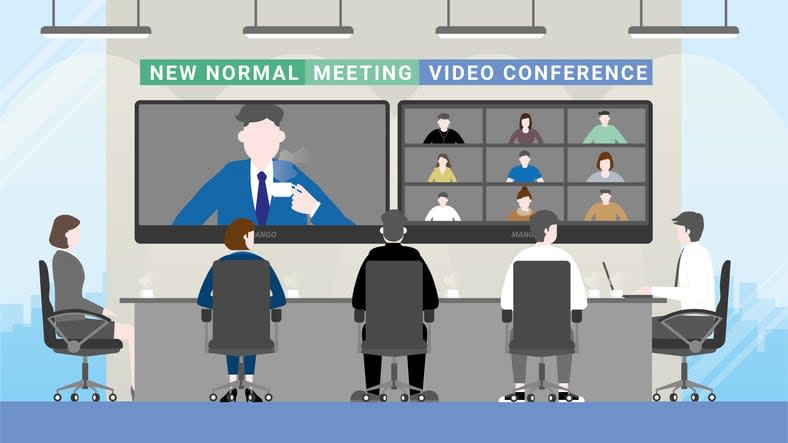When it comes to team collaboration across different locations, mural boards stand out as a go-to resource. These digital canvases allow for real-time connection and idea visualization, essential for today’s distributed teams. We’ll compare top mural board tools, delve into their essential features, and offer practical advice for choosing and using the right one for your team’s unique needs.
Key takeaways
- Mural boards are digital canvases to facilitate inclusive, real-time collaboration among geographically dispersed teams, enhancing decision-making and project progress.
- Effective mural boards offer real-time collaboration capabilities, an extensive library of templates, and integration with other tools to streamline workflows and improve team productivity.
- Selection of the most appropriate mural board tool requires evaluating your team’s needs, comparing pricing and plans, and assessing the customer support and training resources available.
Exploring the world of mural boards

Imagine a virtual whiteboard that transcends the limitations of physicality. A space where teams can collaborate visually, brainstorm solutions, and work together on projects irrespective of their geographical locations.
That’s what Mural offers, and it’s transforming the way we work.
Defining mural boards
Mural boards, in essence, are interactive digital canvases that facilitate real-time collaboration among teams. They facilitate interactive sessions where team members create sticky notes, essential for compiling thoughts and ideas during brainstorming activities. As a ‘thinking canvas,’ mural boards arrange and structure thoughts in various formats such as lists, flowcharts, frameworks, and drawings, making it an indispensable tool in the world of remote teamwork.
The rise of mural boards in remote work
The rising popularity of mural boards among remote and distributed teams stems from their capacity to bring together multiple contributors in a shared virtual space. They offer a more inclusive and accessible platform that accommodates various ways in which people share and process information.
This has led to Mural’s rise in popularity among distributed teams, aligning them by enabling quick decision-making and helping maintain continuous progress on projects.
The essential features of an effective mural board

Characteristics of an effective mural board include:
- The ability to facilitate collaborative work
- The capacity to streamline content addition
- Efficiency is further enhanced with tools for individual work such as shortcuts
- Dashboard management for organization and mural oversight
Let’s delve into some of these essential features.
Real-time collaboration capabilities
Mural boards heavily rely on real-time collaboration capabilities. They allow teams to work together synchronously, facilitating instant sharing of ideas and feedback. Features such as voting mechanisms, the ability to follow a collaborator’s view, and commenting features enable individual contributions to coalesce into a comprehensive team effort.
These tools yield efficient remote workshops, equitable participation, and real-time idea synthesis, even when teams are spread across various countries.
Extensive template library
A broad template library also forms a crucial component of an effective mural board. Pre-built templates provide a structured starting point for collaborative activities, enhancing efficiency and focus during team sessions.
For example, customer experience teams can use specific templates for customer journey mapping, while design thinking templates promote rapid ideation and problem-solving across project stages.
Integration with other tools
Integration with other tools constitutes a significant feature of a competent mural board. Mural integrates with common software applications such as Dropbox, Slack, and Kumospace, expanding its capabilities for team collaboration. This allows for a seamless workflow, keeping all team members connected and enhancing teamwork.
Top mural board alternatives to consider

Despite Mural’s robust features, it’s worth considering several alternatives that offer unique capabilities. Each provides unique features and capabilities, offering a range of options to cater to your team’s specific needs.
Let’s explore some of these alternatives, including Kumospace, Microsoft Whiteboard, and ClickUp.
Kumospace: an immersive team engagement platform
Kumospace is an immersive platform for interactive team engagement. It offers virtual workspaces that boost productivity and transform teamwork dynamics by providing engaging and interactive remote environments.
In fact, Kumospace has been praised for its ability to energize remote culture and collaboration with immersive virtual rooms and social spaces that encourage dynamic interactions.
Kumospace's online whiteboard offers users a collaborative and interactive platform for brainstorming, planning, and visualizing ideas in real time. With its intuitive interface, users can seamlessly draw, write, and add various multimedia elements to the whiteboard, fostering creativity and productivity within teams or classrooms. Its integration with Kumospace's spatial audio technology further enhances the collaborative experience, allowing participants to engage in dynamic discussions while actively contributing to the shared virtual workspace.
Microsoft whiteboard: aligning with Microsoft 365
Microsoft Whiteboard is another alternative. As a part of Microsoft 365, it has standard digital whiteboard features and can be integrated into the Microsoft ecosystem.
ClickUp: beyond basic brainstorming
ClickUp offers a unique twist to the traditional mural board. It goes beyond basic brainstorming by combining whiteboard functions with task management features. This addresses the needs of teams seeking a productivity tool, making it a suitable alternative to consider.
How to choose the right mural board for your team

The process of selecting the most fitting mural board for your team extends beyond mere feature comparison. It requires a thorough assessment of your team’s requirements, a comparison of pricing and plans, and an evaluation of customer support, including priority support, and training resources.
Let’s explore each of these aspects.
Assessing team requirements
Identifying your team’s specific needs is the initial step towards selecting the ideal mural board. This involves identifying the specific needs of your team and how a mural board can meet those needs.
For instance, for hybrid teams, it is recommended that each team member logs in individually to ensure that all contributions are digital and can be easily integrated into the common format.
Comparing pricing and plans
When selecting the most suitable mural board, cost plays a considerable role. It’s important to compare the pricing and plans of various mural board tools and understand what each plan offers.
For instance, Mural’s custom pricing is designed to be flexible and transparent, accommodating unlimited members with unlimited guests, no retroactive billing, or unexpected invoices, making it a viable option for many teams.
Evaluating customer support and training resources
Finally, the availability of customer support and training resources should also be considered when evaluating a mural board tool. A comprehensive resource center with articles, guides, and tutorials, coupled with responsive email and chat assistance, can significantly enhance the user experience, ensuring a smooth onboarding and learning process.
Innovative ways to use mural boards for projects

The application of mural boards extends beyond brainstorming sessions. They can be employed in a myriad of innovative ways for various projects, from ideation and mind mapping to agile and scrum meetings and design thinking workshops.
Let’s delve into each of these uses.
Ideation and mind mapping
One of the most effective ways to use mural boards is for ideation and mind mapping. Mural boards provide a ‘solo brainstorm space’ for individuals to silently brainstorm before group discussions, accommodating diverse working styles.
Furthermore, ideas generated on Mural can be grouped by theme post-collaborative brainstorming, enabling easy identification of patterns and conceptual organization, which is essential when you brainstorm ideas.
Agile and scrum meetings
Mural boards can significantly enhance the effectiveness of Agile and Scrum meetings. They enable sprint planning through goal definition, backlog preparation and refinement, and assignment of work tasks.
Digital whiteboard features of mural tools aid remote Agile teams in visualizing sprints and streamlining task coordination using digital whiteboards, while the in-app chat allows for seamless communication.
Design thinking workshops
Lastly, mural boards can be instrumental in facilitating design thinking workshops. They can be used across all stages, including empathy mapping, brainstorming, and solution definition, even when teams are distributed geographically.
This makes mural boards a versatile tool for enhancing creativity and fostering innovation.
Case studies: successful mural board implementations

The practical application of mural boards proves their versatility and effectiveness, beyond theoretical concepts. Numerous businesses have successfully implemented mural boards and experienced significant improvements in their collaborative efforts.
Let’s take a look at a couple of case studies that illustrate the impact of mural boards on startup innovations and corporate strategy sessions.
Startup innovations
Startups have leveraged mural boards to:
- Swiftly move from concept to prototype
- Enable UX departments to shift their role from simply executing orders to actively generating and iterating innovative ideas
- Significantly enhance their innovation capabilities
- Streamline their product development processes
Corporate strategy sessions
In the corporate setting, mural boards have been incorporated into strategic planning processes, leading to improved remote team engagement and more dynamic interactive sessions. One such example is the company UserTesting, which successfully integrated Mural into their strategy sessions, enhancing collaboration among remote teams and tackling intricate challenges effectively.
Tips and tricks for maximizing Mural Board use

Effective utilization of your mural board is crucial for maximizing its potential. This involves utilizing various communication methods, leveraging the template library, and exploring enterprise-level dashboard features.
Let’s delve into some practical tips and tricks for maximizing mural board use.
Organizing your digital workspace
Mural boards can be organized into ‘Rooms’ which act like folders to categorize and store related murals. Using a ‘group sharing space’ allows the team to discuss and sort ideas by themes or similarities, providing a structured collaborative environment. These organizational features ensure structure and clarity during sessions, leading to more efficient and effective meetings.
Enhancing virtual meetings
Virtual meetings can be greatly improved with the use of mural boards. They can be shared with collaborators directly by email or through a shared link, which enhances the ability to work together in real time. Additionally, engaging in private mode in Mural promotes independent and original idea generation during brainstorming by mitigating the risk of groupthink.
Engaging remote participants
Maximizing the use of mural boards also involves effectively engaging remote participants. Inclusive environments for remote participation are fostered by features such as ‘silent-storming’ and by ensuring all individuals have access to Mural. This levels the playing field and prevents integration issues from different formats, leading to more inclusive and effective collaboration.
Summary
In conclusion, mural boards are an invaluable tool for fostering collaboration and enhancing productivity in remote work environments. With a multitude of features, from real-time collaboration to an extensive template library and seamless tool integration, mural boards have transformed the way we work. Kumospace integrated Mural Board into its virtual office, meaning brainstorming sessions are always on the tip of your tongue. Whether you’re a startup looking to innovate or a corporation seeking to streamline strategy sessions, mural boards offer a versatile and effective solution.
Frequently asked questions
What is a mural board?
A mural board, such as Mural, is a digital collaboration platform that allows teams to work together on brainstorming, strategy, and project planning, regardless of their locations. It is a powerful tool for turning ideas into actionable plans.
Which is better Mural or Miro?
Miro is better for companies needing advanced add-on tools and integrations, and it is also better for cross-functional project collaboration and productive meetings due to its more advanced options and templates. Mural, on the other hand, is easier to use for visual collaboration and well-suited for creative teams, workshops, or small group challenges.
Is Mural part of Kumospace?
Yes, Mural is part of Kumospace, allowing users to take their ideas from imagination to activation and collaborate across teams.
What is the app Mural?
Mural is a digital environment that leverages visual collaboration to help teams unlock ideas and solve problems together, ensuring everyone's voice is heard.
What are some of the essential features of an effective mural board?
Essential features of an effective mural board include real-time collaboration, an extensive template library, and seamless integration with other tools. These features enhance productivity and creativity for teams.





